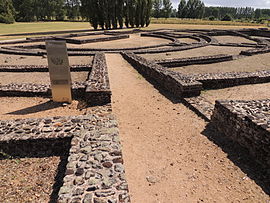Aubigné-Racan (French pronunciation: [obiɲe ʁakɑ̃]) is a commune in the Sarthe department in the region of Pays de la Loire in north-western France.
Aubigné-Racan | |
|---|---|
 The ruins of the theatre | |
| Coordinates: 47°41′29″N 0°16′07″E / 47.6914°N 0.2686°E | |
| Country | France |
| Region | Pays de la Loire |
| Department | Sarthe |
| Arrondissement | La Flèche |
| Canton | Le Lude |
| Intercommunality | CC Sud Sarthe |
| Government | |
| • Mayor (2020–2026) | Nicolas Mourier[1] |
| Area 1 | 32.03 km2 (12.37 sq mi) |
| Population (2021)[2] | 2,103 |
| • Density | 66/km2 (170/sq mi) |
| Time zone | UTC+01:00 (CET) |
| • Summer (DST) | UTC+02:00 (CEST) |
| INSEE/Postal code | 72013 /72800 |
| Elevation | 37–118 m (121–387 ft) (avg. 31 m or 102 ft) |
| 1 French Land Register data, which excludes lakes, ponds, glaciers > 1 km2 (0.386 sq mi or 247 acres) and river estuaries. | |
Population
edit| Year | Pop. | ±% p.a. |
|---|---|---|
| 1968 | 1,858 | — |
| 1975 | 1,942 | +0.63% |
| 1982 | 1,923 | −0.14% |
| 1990 | 2,103 | +1.12% |
| 1999 | 2,100 | −0.02% |
| 2007 | 2,077 | −0.14% |
| 2012 | 2,144 | +0.64% |
| 2017 | 2,120 | −0.22% |
| Source: INSEE[3] | ||
Sights
editIn the surrounding countryside, one can find prehistoric standing stones, or dolmens ("dolmen de la Pierre" and "dolmen du Colombier").
Aubigné-Racan is also the site of the archeological excavation of Cherré, a Gallo-Roman complex of 20 hectares from the 1st to the 3rd centuries. The site was likely a rural centre of commercial and religious activity before the Roman conquest. Excavations in 1977 by C. Lambert and J. Rioufreyt discovered an ancient theatre, two temples, Roman thermae, a forum and an aqueduct.
The town has a Romanesque church from the 11th century.
People
editAubigné-Racan is the birthplace of the 17th century poet and dramatist Honorat de Bueil, seigneur de Racan. His birthplace, the Manoir de Champmarin, is still standing.
See also
editReferences
edit- ^ "Répertoire national des élus: les maires". data.gouv.fr, Plateforme ouverte des données publiques françaises (in French). 9 August 2021.
- ^ "Populations légales 2021" (in French). The National Institute of Statistics and Economic Studies. 28 December 2023.
- ^ Population en historique depuis 1968, INSEE



